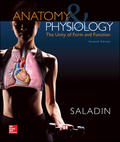
Introduction:
A joint is a region where two bones or a bone and a cartilage meet. The humerus is the bone of the upper arm that runs from the shoulder to the elbow. The humerus connects with the scapula to form the shoulder joint. Rotation is the movement of the bone around an axis. Internal rotation occurs when the shoulder revolves towards the midline and external rotation occurs when the movement occurs away from the midline.
Answer to Problem 1TYR
Correct answer:
The internal and external rotation of the humerus occurs because it is a ball-and-socket joint. Therefore, option c is correct.
Explanation of Solution
Justify reasons for the correct statement:
The ball and socket joint is a multiaxial synovial joint that allows movements such as flexion, extension, external and internal rotation in multiple axes.
Option (c) is given as, “ball-and-socket joint”.
The shoulder bone, the humerus is an example for ball and socket joint. The ball and socket joint occurs when the humerus head, which is ball shaped, fits into the socket of another bone, the scapula. It is a highly mobile joint that is involved in both internal and external rotational movements.
Hence, option (c) is correct.
Justify reasons for the incorrect statements:
Option (a) is given as, “pivot”.
Pivot joint is a freely movable synovial joint. It is a uniaxial joint that allows rotational movement only in a single axis. So, it is a wrong answer.
Option (b) is given as, “condylar”.
A condyloid joint is a biaxial joint that allows movement, such as flexion, adduction, and extension in two axes. It does not allow rotational movement. Therefore, it is a wrong answer.
Option (d) is given as, “saddle”.
The saddle joint occurs in the bones that are saddle shaped. It is a synovial joint that allows movements such as flexion, abduction, and circumduction but no rotation. Hence, it is a wrong answer.
Option (e) is given as, “hinge”.
Hinge joint is a type of synovial joint. It allows movements such as flexion and extension in a single axis. So, it is a wrong answer.
Hence, options (a), (b), (d), and (e) are incorrect.
The humerus produces both internal and external rotation because it is a ball-and-socket joint.
Want to see more full solutions like this?
Chapter 9 Solutions
EBK ANATOMY & PHYSIOLOGY: THE UNITY OF
- What is behavioral adaptarrow_forward22. Which of the following mutant proteins is expected to have a dominant negative effect when over- expressed in normal cells? a. mutant PI3-kinase that lacks the SH2 domain but retains the kinase function b. mutant Grb2 protein that cannot bind to RTK c. mutant RTK that lacks the extracellular domain d. mutant PDK that has the PH domain but lost the kinase function e. all of the abovearrow_forwardWhat is the label ?arrow_forward
- Can you described the image? Can you explain the question as well their answer and how to get to an answer to an problem like this?arrow_forwardglg 112 mid unit assignment Identifying melting processesarrow_forwardGive only the mode of inheritance consistent with all three pedigrees and only two reasons that support this, nothing more, (it shouldn't take too long)arrow_forward
- Oarrow_forwardDescribe the principle of homeostasis.arrow_forwardExplain how the hormones of the glands listed below travel around the body to target organs and tissues : Pituitary gland Hypothalamus Thyroid Parathyroid Adrenal Pineal Pancreas(islets of langerhans) Gonads (testes and ovaries) Placentaarrow_forward
- Basic Clinical Lab Competencies for Respiratory C...NursingISBN:9781285244662Author:WhitePublisher:Cengage
 Medical Terminology for Health Professions, Spira...Health & NutritionISBN:9781305634350Author:Ann Ehrlich, Carol L. Schroeder, Laura Ehrlich, Katrina A. SchroederPublisher:Cengage Learning
Medical Terminology for Health Professions, Spira...Health & NutritionISBN:9781305634350Author:Ann Ehrlich, Carol L. Schroeder, Laura Ehrlich, Katrina A. SchroederPublisher:Cengage Learning  Fundamentals of Sectional Anatomy: An Imaging App...BiologyISBN:9781133960867Author:Denise L. LazoPublisher:Cengage Learning
Fundamentals of Sectional Anatomy: An Imaging App...BiologyISBN:9781133960867Author:Denise L. LazoPublisher:Cengage Learning





